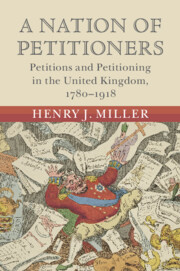Book contents
- A Nation of Petitioners
- Modern British Histories
- A Nation of Petitioners
- Copyright page
- Dedication
- Contents
- Figures
- Tables
- Acknowledgements
- Abbreviations
- Introduction
- Part I Petitions
- 1 Petitions to the House of Commons I
- 2 Petitions to the House of Commons II
- 3 Subscriptional Cultures and Petitionary Documents
- Part II Petitioners
- Part III Petitioning
- Select Bibliography
- Index
2 - Petitions to the House of Commons II
Issues
from Part I - Petitions
Published online by Cambridge University Press: 02 February 2023
- A Nation of Petitioners
- Modern British Histories
- A Nation of Petitioners
- Copyright page
- Dedication
- Contents
- Figures
- Tables
- Acknowledgements
- Abbreviations
- Introduction
- Part I Petitions
- 1 Petitions to the House of Commons I
- 2 Petitions to the House of Commons II
- 3 Subscriptional Cultures and Petitionary Documents
- Part II Petitioners
- Part III Petitioning
- Select Bibliography
- Index
Summary
Public petitions to the Commons encompassed a diverse range of political, religious, social, and economic topics. This chapter examines the 33,000 or so different issues that were raised by petitioners to the House of Commons. The initial expansion of petitioning in the late eighteenth century was associated with subjects relating to economic regulation and taxation. From the early nineteenth century, the volume of petitions (and signatures) on economic topics was outstripped by the surge of petitioning on religious and social issues. The analysis reveals that petitions were a crucial means for addressing religious issues across the four nations, as well as for debating the UK’s constitutional arrangements. The chapter then considers the different types of issue, from those linked to mass campaigns, to the ‘long’ tail of petitions concerning medium and small-scale topics. Petitions remained an important mechanism for raising individual grievances, particularly from women, in Parliament. Finally, one of the limitations of the petitions data is the relative absence of petitions concerning the empire or foreign policy, which is attributable to the clerks’ system of categorisation and the appeal of petitioning other authorities.
Keywords
- Type
- Chapter
- Information
- A Nation of PetitionersPetitions and Petitioning in the United Kingdom, 1780–1918, pp. 50 - 71Publisher: Cambridge University PressPrint publication year: 2023

